Caunes-Minervois
| Caunes-Minervois | ||
|---|---|---|

Abbey
|
||
|
||
| Coordinates: 43°19′39″N 2°31′44″E / 43.3275°N 2.5289°ECoordinates: 43°19′39″N 2°31′44″E / 43.3275°N 2.5289°E | ||
| Country | France | |
| Region | Occitanie | |
| Department | Aude | |
| Arrondissement | Carcassonne | |
| Canton | Peyriac-Minervois | |
| Intercommunality | Haut Minervois | |
| Government | ||
| • Mayor (2008–2015) | Jacques Molina | |
| Area1 | 27.84 km2 (10.75 sq mi) | |
| Population (2008)2 | 1,598 | |
| • Density | 57/km2 (150/sq mi) | |
| Time zone | CET (UTC+1) | |
| • Summer (DST) | CEST (UTC+2) | |
| INSEE/Postal code | 11081 /11160 | |
| Elevation | 144–861 m (472–2,825 ft) (avg. 176 m or 577 ft) |
|
|
1 French Land Register data, which excludes lakes, ponds, glaciers > 1 km² (0.386 sq mi or 247 acres) and river estuaries. 2Population without double counting: residents of multiple communes (e.g., students and military personnel) only counted once. |
||
1 French Land Register data, which excludes lakes, ponds, glaciers > 1 km² (0.386 sq mi or 247 acres) and river estuaries.
Caunes-Minervois is a small medieval town or “commune” in the Aude department in the Occitanie region in southern France. It is known particularly for its ancient Abbey, dating from the eighth century, and the outstanding red marble that has been quarried locally from Roman times. The name may derive from the ancient local Occitan word for cave, “cauna”, of which there are a number in the immediate area.
Caunes is also in the Minervois, a designated wine growing region with AOC status but with an ancient heritage. The name derives from the ancient regional capital of Minerve, some 20 km east of Caunes, itself named for the Roman Goddess Minerva. The Romans came through here, settling and introducing vines & olives in the region. Minervois Vignerons have been dynamic in changing the perception of the world towards wine from the south of France, developing quality products and experimenting with both old and new grape varieties and techniques.
The ruined castle (chateau) at Minerve is a site attracting many visitors due to the ongoing interest in Catharism and the Albigensian Crusade. Caunes lies in the northern part of the modern touristic region of the “Pays Cathare” – Cathar Country – which stretches here from the Pyrenees.
The town sits at the foot of the Montagne Noir which are themselves the southernmost extent of the Massif Central. The change in slope designates a change in geology from the predominantly metamorphic rocks of the nearby mountains to the alluvial deposits of the plains.
The settlement lies adjacent to the mountain river L’argent Double which can be a torrent after rain but usually has a gentle and semi-continuous flow, sometime disappearing completely below a bouldery riverbed. Highest flows are usually recorded in February falling away throughout the dry months. This river is a key attribute that lead to early settlement here, both in terms of the important pass created by its valley and the regular, sweet water supply. The river name l’Argent Double is purported to come from the Latin Argent meaning silver and Celtic dubrum, meaning water. Whether this refers to just the colour of a tumbling stream, the fact that the water is sweet (soft), or some other mineral content is not clear.
...
Wikipedia



